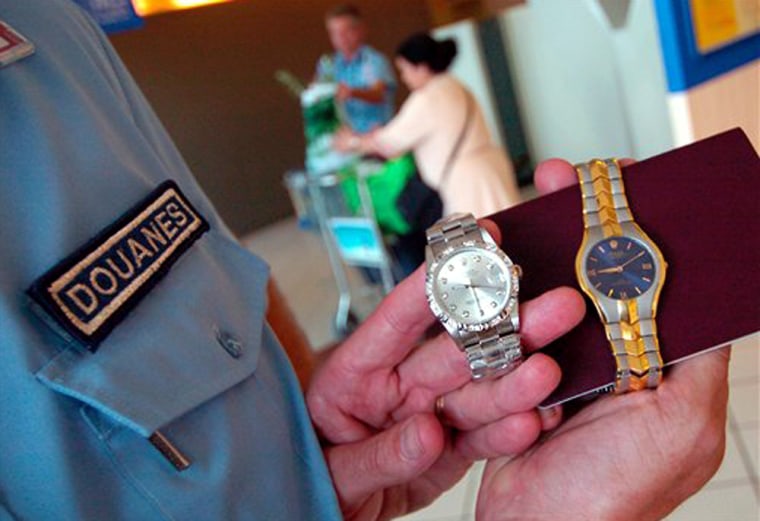The man was sweating as he edged toward the blue-uniformed customs agents framing the doorway — his only exit. Red-faced and incongruous in the air-conditioned cool of the arrivals area, he never had a chance.
Officers had singled out the French vacationer even before he touched down at Saint Exupery airport, on the outskirts of the southern city of Lyon. Poring over a flight manifest, they noticed he was the only passenger returning from Thailand, a major source of illegal counterfeit goods.
Brigade Commander Bernard Mortelette opened the luggage the man was carrying, and noticed something wasn’t right.
“We put it to him that this probably wasn’t his suitcase because it had a woman’s clothes inside it,” he explained later. The case was restored to its concerned owner. Inside the 38-year-old engineer’s unclaimed luggage — which he may have planned to retrieve after the officers had left — were two fake Rolexes, still wrapped.
The lengths to which panicked tourists will go to avoid detection of their illicit souvenirs is one result of the tougher approach to counterfeiting in France.
With one of the world’s richer concentrations of luxury goods makers to defend, France increased the maximum fine for buying fakes in March to three times the retail price of the authentic product.
A 30 euro ($40) fake Rolex could incur a 10,000 euro ($12,000) penalty. The same month, Italy introduced fines of up to 10,000 euros ($12,400) for buying rip-off goods.
The Colbert Committee, which represents French luxury brands, estimates that counterfeits cost the country 30,000 jobs. It wants other governments to crack down on buyers as well as sellers.
“There’s a problem of supply, but there’s also a problem of demand,” said Nicolas Prelot, the group’s project manager on counterfeiting. “Ordinary consumers who buy forgeries should also receive convictions.”
The French and Italian laws are among the harshest in the world for individuals caught with counterfeit goods for their own use.
U.S. laws provide for tough sanctions against individuals who carry out piracy or counterfeiting — even on a small scale, for example by illegally downloading music on their computers — but don’t penalize those who buy the fake finished products.
“In most countries around the world the consumption of infringing products is not a crime,” said Eric Smith, president of the Washington-based International Intellectual Property Alliance.
But police concerns that terrorist groups are cashing in on counterfeiting — which may account for as much as 7 percent of world trade, according to the Paris-based Organization for Economic Cooperation and Development — have added a new sense of urgency.
Toiletries to brake pads
Interpol says intercepted fakes ranging from toiletries and cigarettes to brake pads and music CDs have already been linked to groups including al-Qaida, Hezbollah, the Irish Republican Army and the FARC rebels of Colombia.
“It’s quite clear that paramilitary organizations, and the best example is Northern Ireland, are heavily involved in the manufacture and distribution of counterfeit goods,” said John Newton, head of intellectual property crime at the Lyon-based international police organization.
A study prepared for the European Union reached similar findings last month, and Brussels announced plans to require all 25 member countries to treat the commercial manufacture or supply of counterfeits as a criminal offense punishable by imprisonment.
The European Commission also cited health and safety hazards posed by much of the ever-growing range of products forged on an industrial scale — extending far beyond handbags and watches.
“Fake luxury goods are the most visible and do a lot of harm in France, but we estimate that they amount to about 5 percent of the global market for counterfeits,” said Marc-Antoine Jamet, head of Union des Fabricants, a French manufacturers’ association.
Besides the ubiquitous pirated films and software, there is a growing international trade in fake toys, medicines, foodstuffs, spare parts for cars and even passenger jets.
Since June, about 250 Chinese schoolchildren have become ill and dozens were hospitalized with breathing problems after being given fake vaccines. At least one is reported to have died.
“Developing countries are the biggest victims of counterfeiting,” Jamet said. “In some African states, 85 percent of all medicines sold are fakes.”
Lyon customs agents are under no illusion about their main adversary. An antique newspaper illustration, framed on their office wall, underlines the challenge with a simple caption: “A French customs inspector is murdered by the Chinese.”
China consumes the lion’s share of its own vast counterfeit output, but the remainder sold overseas is still enough to make it the world’s largest exporter of fakes — in ever more ingenious ways.
Over the past month, officers inspecting freight shipments have unearthed thousands of imitation Chanel earrings, fake Von Dutch T-shirts and bracelets bearing the Nike swoosh.
But it was a much smaller find that really got their attention, Division Chief Pascal Regard said as he handled three crudely stitched, unmarked handbags — discovered, like most of the month’s booty, in a shipment from China.
From openings cut into the rubberized fabric by an observant inspector emerged two fake Chanel bags and one Louis Vuitton that had been sewn into the linings.
The discreet shipment of immaculate fakes — distinguishable to the untrained eye only by the faulty grammar on their forged guarantees — was probably a dry run for a larger planned shipment, Regard said.
“I’d like to see this as a compliment to us,” he said. “But now it’s up to us to get the message and adapt to the new techniques. They’re changing all the time.”
